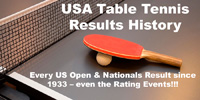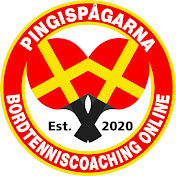Tip of the Week
Practice Each Aspect of a Technique Separately.
Weekend Coaching
I did four group sessions over the weekend, 6.5 hours. Sunday seemed iffy because of the predicted snow, but it came about five hours later than expected, so we got both sessions in. Because of the snow, I couldn’t get my car up the hill outside our club! But one of the parents literally got behind my car and pushed, and we managed to get to the top (fifty yards at most) though it took about five minutes.
I had one session with our top junior group, rated from 1800 to 2550. One of our best players was having trouble covering his wide backhand when blocking – I pointed out that it was a ready position problem, that he was holding his racket to far out in front and so didn’t have time to bring it back against deep attacks to his wide backhand. I also got another of our top players to better disguise his serve – he was setting up differently for regular and reverse pendulum serves. You need to always set up the same way, and hide which you are doing until the last possible moment.
We had one new player in our junior program on Sunday, age 8, who’d never had lessons. I worked with him for over an hour, first alternating between him and one other in multiball, and then one-on-one the last 20 minutes. He started out with this awkward lunging forehand, where his whole body would lean forward as he hit the ball, ending up almost falling on the table. He could barely do two shots in a row this way. The keys to fixing it up were: 1) telling him to imagine a rod going through the top of his head and to just circle the rod as he stroked – if he moved forward in the swing, it would destroy his brain!; 2) Having him bring his arm in, since he tended to extend his arm almost straight, which gave him extra forward momentum and caused a complete lack of control; 3) keeping left arm up for balance; and 4) Guiding him through the stroke repeatedly. In the first 15 minutes he couldn’t hit more than two in a row, and the second one was always rather wild. By the end he got over 50 in a row several times with a good stroke, and was doing footwork drills with it. As I reminded him and others, it’s most important to gave a good stroke and contact; hitting the table is a distant third until you get the first two.
On the backhand, he reached for the ball and had a stroke bigger than Godzilla’s. The key to fixing this, besides shortening the stroke, was to tell him to think of himself as a soccer goalie, and get his stomach in the way of every shot. That got him into position, and then it was just a matter of doing the stroke I’d repeatedly guided him through. He managed to get over 30 in a row at the end.
My Shoulder Gives Me the Cold Shoulder
Fresh off winning both Over 40 and Over 60 Hardbat at the US Open and quarters of Over 60 Men, and with cataract surgery on both eyes coming up in February so I can go back to reading service and other spins (and thereby perhaps challenge for Over 60 Men’s Singles at the Nationals in July, along with hardbat events), I was all excited about playing this year. I’ve been primarily a coach since circa 1985 (other than 1990-91), but now am training again to compete in age and hardbat events. I normally use sponge, but with my cataracts – 20-70 and 20-150 vision in my left and right eyes) it’s difficult to read serves especially, but that should be fixed with the cataract surgery.
So, on Friday, I had my first real training session since the Open a month ago. And 35 minutes in, I had to stop – my shoulder was once again hurting. It’s been an on-and-off thing for years, but progressively has gotten worse. So, that very afternoon, I saw a sports orthopedist, and I have the diagnosis: “Incomplete rotator cuff tear or rupture of right shoulder.” And so I won’t be training for a month or more. This week I have an MRI scheduled and start work with a physical therapist. I can still play – I was a practice partner for some of the sessions this week – but cannot play aggressive backhands and have to careful when extending my arm on forehand shots, or going for bit forehand loops. Basically, I’m just going to block for a while, and maybe even chop some. (All this after spending last year battling knee, foot, and back issues. The trials and tribulations of trying to be a forehand attacker at age 65 next month.)
Inner Excellence: Train Your Mind For Extraordinary Performance and the Best Possible Life
I kept hearing about this book (by Jim Murphy, former professional baseball player), so I finally decided to buy and read it. It was pretty good, though of course some of it is similar to what various sports psychology books suggest, but it put a lot of good info together. Here are three quotes from the book that I jotted down.
- P54 BFF – Belief, Focus, Free[dom]. These are three pillars of play that apply directly to table tennis. If you believe in your shots, focus, and play free (i.e., relaxed and let your training take over), you will maximize your play and your chances of winning.
- P165 “Simplicity is the key to brilliance.” -Bruce Lee. This is something I harp on in my Table Tennis Tactics for Thinkers book, where I open the book by writing, "Tactics isn't about finding complex strategies to defeat an opponent. Tactics is about sifting through all the zillions of possible tactics and finding a few simple ones that work."
- P223 “The opponent is not the enemy, they’re our partner in the dance.” -Phil Jackson. If you think this through, it makes great sense. Without an opponent, you can’t do anything, so your opponent is your partner, a specific playing style and level. If you hold up your end of the partnership, you win! If you don’t, then practice until you can.
The Importance of . . . Letting Go of the Fear of Missing (Episode #1)
Here’s the video (16:54) from Neil Myatt Table Tennis. Some good points – but the most important part is at 8:05 when he talks about Table Tennis Tactics for Thinkers, and then talks about the difference between tactical and strategic thinking, which is from the book.
Major League Table Tennis
Follow the action!
- Home Page
- Major Pong Head (blog coverage)
- Philadelphia to Host 2025 MLTT Championship Weekend
- IT’S MLTT WEEK 8! Let’s Go, Pomona
- Here’s the hilarious video (59 sec) posted by Sean O’Neill (the second person to appear, “The man with the heart of a champion”), who wrote, “I am part of MiLTT in Portland. Here is our Pre-Draft Video. This is going to be Epic!” It’s their Minor League Table Tennis Preview.
Illegal Chair of the USATT Board
It’s now been 714 days (102 weeks) since USATT elected Richard Char to an illegal third term as chair of the USATT board on Feb. 6, 2023 – such a stain on our legacy. Here’s my July 1 blog about it. Assuming they follow the USATT bylaws this time, they will elect a new chair at the first board meeting in 2025. No meeting has yet been scheduled in the USATT Agendas and Notices page, which doesn’t yet have a 2025 listing. Char will continue as a USATT board member. I have no idea who might run for or get elected as the new chair. Strangely, the USATT Board Listing no longer has anyone listed as chair.
Butterfly Training Tips
- Forehand Flip and Backhand Loop Combo (62 sec) with Rachid El Bou Bou
- Topspin Defensive Looping (85 sec) with Yu Di
From Player to Coach: How the ITTF Level 1 Coaching Course Changed My Perspective
Here’s the article by Álvaro Munno. Interesting perspective. I took the Level 1 and Level 2 courses a number of years ago, and taught an ITTF Level 1 course, similar to the one he writes about.
If You Cheat, You’re Gonna Get Beat
Here’s the video (36:46) from Louis Levene, alias “Looee Looee.”
New from Olav Kosolosky
- The Banana Flick: Turn Your Receives Into A Weapon (11:09)
- My Best Points & Highlights Of 2024 (8:17)
- The Forehand Counterspin: How to Counterloop Effectively and with Quality (11:44)
- The 3rd Ball: the Most Dangerous Shot in the Game (8:02)
Transitioning Between Smooth Forehand and Pips Backhand with Yang Xiaoxin
Here’s the video (2:42) from PongSpace.
A Guide to Table Tennis Etiquette
Here’s the article by Tom Lodziak.
Table Tennis Balls: What Is The Difference Between 38 mm Ball And 40 mm Ball
Here’s the video (3:27) from Pingispågarna.
USA Table Tennis Announces Coaching Leadership for 2025-2028 Quadrennial
Here’s the USATT news item.
Attack vs. Chop Point
Here’s the video (40 sec) – just a good point showing how to patiently play a defensive chopper. But most choppers won’t make that many effective returns!
Academic Eligibility Form--Spring '25 and Post Season
Here’s the news item from NCTTA.
New from Steve Hopkins/Butterfly
New from the ITTF
- ITTF Competition Managers Workshop: Building Regional Expertise in Africa
- ITTF Welcomes Unprecedented Bidding Race for World Championships 2027-2028-2029
- ITTF Unveils Enhanced Racket Control Process
- Olympic Champion Ryu Seung-min Elected as Korean Olympic President
- ITTF Concludes Positive Inspection Visit for Doha 2025
- Table Tennis Sets Sights on Spectacular 2025: World Cups
Top TT Moments of 2024
Here’s the video (65 min) from Table Tennis Daily.
Lots of Ping-Pong Shirts
Here they are from Walmart!
The Ghost Serve or the World’s Fastest Serve?
Here’s the video (9 sec)!
If a Giant Ape and a Table Tennis Player Got Into an Argument...
Here’s the video (18 sec) from standup comic Jimmy Carr!
150 Ping Pong Team Names: Funny, Cool & Catchy Ideas
Here’s the article and listing!
Non-Table Tennis - Alternative Liberties and Upcoming Stories
Tonight from 6-9PM Eastern Time there will be a reading from some of the authors from the new anthology, Alternative Liberties, which just came out today in kindle format. (Here is the Print version.) I’m one of the authors (“Legacy”), and will be doing my reading around 8:15PM or so. My story is 1,200 words, but all the authors are supposed to read just the first 600 or so words – you’ll have to get the book to get the rest! All of the stories are basically in opposition to the incoming administration that starts today. It’s actually one of a series of books in the Alternative Truths series – I have a story in each one.
On a related note, it’s going to be a wild week for me. From Jan. 20-31, I have five new science fiction/fantasy stories coming out (yes, I get paid for them!), and I’m interviewed on Thursday. I’ll post links to these in my next two blogs. These days I'm 50-50 between TT and SF.
***
Send us your own coaching news!





